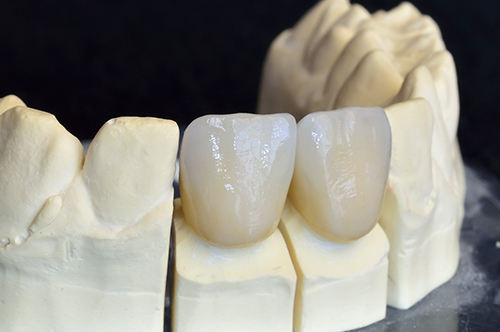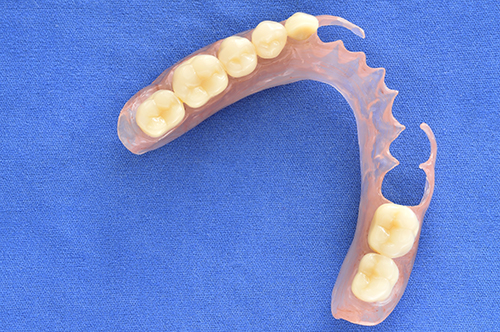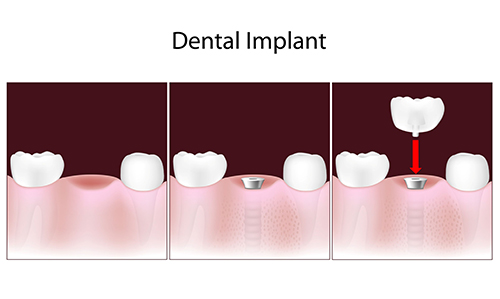Porcelain Crowns

A crown is a type of dental restoration which completely encircles remaining tooth structure or a dental implant. It is necessary to fabricate a crown when there is not enough healthy tooth structure remaining to support filling materials or when restoring dental implants.
Crowns are made of porcelain fused to a metal substrate or can be completely made of ceramic materials.
Crowns are typically used to restore a tooth’s function and appearance following a restorative procedure such as a root canal. When decay in a tooth has become so advanced that large portions of the tooth must be removed, crowns are often used to restore the tooth.
Crowns also serve an aesthetic use, and are applied when a discolored or stained tooth needs to be restored to its natural appearance.
Procedures
A tooth is usually reduced in size to accommodate a crown. An impression is taken and a cast is made of the existing teeth. The impression is sent to a special lab, which manufactures a custom-designed crown. A temporary crown is applied until the permanent crown is ready to be inserted.
Caring For Your Crowns
With proper care, a crown can last for many years. It is very important to follow the same oral hygiene instructions that are followed for natural teeth.
Removable Bridges

A removable bridge, more commonly known as a denture, is a removable replacement for missing teeth and adjacent tissues. It is made of acrylic resin, sometimes in combination with various metals.
Types of Dentures
Complete dentures replace all the teeth, while a partial denture fills in the spaces created by missing teeth and prevents other teeth from changing position.
Candidates for complete dentures have lost most or all of their teeth. A partial denture is suitable for those who have some natural teeth remaining. A denture improves chewing ability and speech, and provides support for facial muscles. It will greatly enhance the facial appearance and smile.
Complete or full dentures are made when all of your natural teeth are missing. You can have a full denture on your upper or lower jaw, or both.
Complete dentures are called “conventional” or “immediate” according to when they are made and when they are inserted into the mouth. Immediate dentures are inserted immediately after the removal of the remaining teeth. To make this possible, the dentist takes measurements and makes the models of the patient`s jaws during a preliminary visit.
An advantage of immediate dentures is that the wearer does not have to be without teeth during the healing period. However, bones and gums can shrink over time, especially during the period of healing in the first six months after the removal of teeth. When gums shrink, immediate dentures may require rebasing or relining to fit properly. A conventional denture can then be made once the tissues have healed. Healing may take at least 6-8 weeks.
An overdenture is a removable denture that fits over a small number of remaining natural teeth or implants. The natural teeth must be prepared to provide stability and support for the denture.
Partial dentures are often a solution when several teeth are missing.
How are dentures made?
The denture process takes about one month and five appointments: the initial diagnosis is made; an impression and a wax bite are made to determine vertical dimensions and proper jaw position; a “try-in” is placed to assure proper color, shape and fit; and the patient`s final denture is placed, following any minor adjustments.
Getting used to your denture
For the first few weeks, a new denture may feel awkward or bulky. However, your mouth will eventually become accustomed to wearing it. Inserting and removing the denture will require some practice.
Start out by eating soft foods that are cut into small pieces. Chew on both sides of the mouth to keep even pressure on the denture. Avoid sticky or hard foods, including gum. You may want to avoid chewing gum while you adjust to the denture.
Adjustments
If your denture no longer fits properly, if it breaks, cracks or chips, or if one of the teeth becomes loose, see your dentist immediately. In many cases, dentists can make necessary adjustments or repairs, often on the same day. Complicated repairs may require that the denture be sent to a special dental laboratory.
Denture adhesives
Denture adhesives can provide additional retention for well-fitting dentures. Denture adhesives are not the solution for old, ill-fitting dentures. A poorly fitting denture, which uses constant irritation over a long period, may contribute to the development of sores. These dentures may need a reline or need to be replaced. If your dentures begin to feel loose, or cause pronounced discomfort, consult with your dentist immediately.
Porcelain Laminates
Porcelain veneers, sometimes called tooth veneers, can be used to correct both color and shape problems and make for a great smile makeover.
Overview of Tooth Veneers
Often an alternative to crowns, veneers are very thin pieces of specially-shaped porcelain that are glued over the front of your teeth with little or no anesthesia needed. They are the cure for teeth that are severely discolored, chipped, have small holes or pits, misshapen or crooked, or for the correction of unwanted or uneven spaces. Unlike crowns, veneers won’t require the dentist to remove much of the tooth itself in most cases. It is important to ask your cosmetic dentist how much tooth will be removed. In some cases more tooth will need to be removed, which may increase the risk of trauma to the tooth. Veneers are created from an impression taken in your cosmetic dentist’s office. Your custom veneer is then glued directly onto your tooth. Typically costing less than crowns, veneers won’t stain, making veneers a very popular solution for many people seeking that perfect smile. Strong and very durable, veneers last from ten to fifteen years, and come in colors that will brighten dark teeth without the worry of them changing color.
How are Tooth Veneers Attached to your Tooth?
In your first appointment, it is important to initially discuss with your cosmetic dentist that you will want to “try in” your veneers with temporary cement that is the same color cement as will be used for the permanent attachment. During this “try-in” phase, be sure to look at your veneers in natural light in addition to the office light. Teeth are prepared for veneers by lightly buffing to allow for the small added thickness of the veneer. Veneers are thin like contact lenses, and will usually only need tooth reduction of 0.5mm to 1.0mm. If a drastic change is being made for the result you want, reduction may be 1.0mm to 2.0mm. A mold is taken of the teeth, from which the veneers are modeled after. Temporary veneers will be placed and worn until your permanent veneers are ready. While wearing the temporary veneers, advise your cosmetic dentist of any adjustments or changes you would like made, such as in shape or size. These changes will be translated into your permanent veneers, so good communication between you and your dentist is important in achieving your new smile.
Your dentist places the veneers with water or glycerin on the teeth to verify their perfect fit and the shade or color. The color cannot be changed after the veneers are adhered to your teeth. The tooth is then cleansed with chemicals to achieve a durable bond. Once the glue is between the veneer and your tooth, a light beam is used to harden the glue/cement.
Dental Bonding
The dental bonding procedure utilizes a composite resin and is used for a variety of structural as well as cosmetic purposes. One can draw a parallel between dental bonding materials and a sculptor’s clay. By using dental composite resin bonding your dentist can restore chipped or broken teeth, fill in gaps and reshape or recolor your smile.
A very mild etching solution is applied to your teeth to create very small crevices in the tooth’s enamel structure. These small crevices provide a slightly rough surface permitting a durable resin to bond materials to your teeth. The resin is then placed on your tooth and high-intensity light cures the resins onto your tooth’s surface – with each individual layer of resin hardening in just minutes. When the last coat has been applied to your tooth, the bonded material is then sculpted to fit your tooth and finely polished.
The resin comes in many shades so that we can match it to your natural teeth. Due to the layers involved, this procedure will take slightly longer than traditional silver fillings because multiple layers of the bonding material are applied. Typically bonding takes an hour to two hours depending on your particular case
For small corrections
These fillings are color-matched to the tooth and are bonded to the surface for added strength. These are most appropriate for small fillings and front fillings as they may not be as durable for large fillings.
Teeth Whitening
Whitening of the teeth is performed for patients who desire a brighter smile. Tooth whitening can be performed to reduce discoloration and staining, or simply to provide the patient with whiter, brighter teeth.
Overview of Teeth Whitening
Teeth whitening is used to correct discoloration of the teeth by removing the brown and yellow staining. The term “teeth whitening” can refer to a number of techniques to improve the brightness of the patient’s teeth. Among them are chemical whitening, mild acid whitening, abrasive teeth brightening and the newest technique, laser teeth whitening.
Teeth Whitening
Teeth whitening is a chemical process used to lighten the color of the patient’s teeth. The procedure can be performed entirely in the dental office or it can be performed by the patient in their home, using materials provided by the dentist. The home method is often used because it saves the patient from having to make an office visit for each treatment.
Before the patient embarks on the home teeth whitening regimen, the cosmetic dentist creates a custom mouth tray for the patient. The custom tray is a critical component of the treatment. It ensures that the correct amount of whitening solution is used and that the patient’s teeth are properly exposed to the whitening solution. The custom made mouth tray provides for a better fit than a one-size-fits-all mouth tray to help increase the margin of patient safety.
The steps in the home teeth whitening regimen are fairly straightforward. The cosmetic dentist’s office provides the patient with the materials and instructions and also answers questions the patient may have about the routine.
A home whitening session can last for two to three hours, during which time you will have the tray and solution in your mouth. Depending upon your needs and desired results, your dentist may instruct you to keep the tray in your mouth overnight. Typically, you will follow your home teeth whitening regimen for two to three weeks, after which time you will return to your cosmetic dentist for a follow up visit.
How long does teeth whitening last?
Teeth whitening is not a permanent procedure. Results can last for one or more years, depending upon your personal habits. In most cases, the whitening procedure is very effective and the patient is pleased with the results.
Orthodontics
Our office offers pre treatment and post treatment for Braces and Invisalign
Implants

Dental Implants are a great advancement in dentistry as they permanently replace missing teeth in a way that no previous dental technique was able to accomplish. Implants are anchors made out of the strongest titanium materials, that are implanted into the bone and then covered with a cap or denture. They are stronger than a natural root and will never require a root canal or filling. An implant will help maintain the health and shape of the bone in the jaw area, and neighboring teeth do not need to be filed down to make room for it.
It is imperative that the dentist performing the implant be experienced and skilled in all the proper techniques of implant dentistry. When done successfully, an implant will result in a comfortable and natural looking tooth, thereby providing a permanent solution to a missing tooth.
